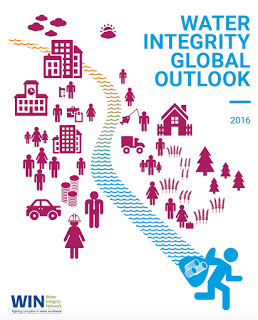

| Online: | |
| Visits: | |
| Stories: |

| Story Views | |
| Now: | |
| Last Hour: | |
| Last 24 Hours: | |
| Total: | |
Water Integrity Global Outlook — the review
Read aguanomics http://www.aguanomics.com/ for the world’s best analysis of the politics and economics of water Back in 2008, Transparency International highlighted the depth and impact of corruption on operations in the water sector. In this post on that report, I wrote:
To understand why water provision is especially vulnerable to corruption, consider this “equation”:Corruption = monopoly + discretion – accountability.
Thus, you see why I spend so much time on this blog discussing the troubles with monopolies, asymmetric information (water managers know more than us), and community oversight of water agencies.
 Those problems have not gone away,* so I was interested to see the update on that report, the Water Integrity Global Outlook (WIGO) that the Water Integrity Network (a spinoff of TI) published on World Water Day this year.
Those problems have not gone away,* so I was interested to see the update on that report, the Water Integrity Global Outlook (WIGO) that the Water Integrity Network (a spinoff of TI) published on World Water Day this year.
This edition was disappointing, as it seemed to put far more weight on managed, bureaucratic “solutions” than creative, community control. Consider their recommendations:
Overall recommendations
- Ensure the full involvement of all relevant stakeholders in processes to build integrity and fight corruption in the water sector.
- Generate reliable data on the extent of corruption in the water sector and the economic and social damage that results.
- Put principles into practice: build ‘integrity walls’ appropriate to the context.
Chapter 1: A Global Mandate for Water Integrity
- Explicitly recognize and address the lack of integrity and the presence of corruption as major concerns in water governance and management.
- Strengthen water integrity in order to support the implementation of the SDGs and ensure the fulfilment of the human rights to water and sanitation.
Chapter 2: How Policies and Laws Can Support Water Integrity
- Develop and enforce water policies that incorporate TAP [Transparency, Accountability and Participation] principles along with anticorruption measures in accordance with the obligations of the human rights to water and sanitation.
- Ensure public scrutiny and balance stakeholder interests in political and legislative processes.
Chapter 3: Following the Money
- Establish a comprehensive accountability mechanism anchored in the public finance system for water sector financing from all sources.
- Engage with ministries of finance, audit institutions and parliamentarians to make water and sanitation a priority and increase their understanding of the sector.
Chapter 4: From Planning to Implementation
- Strengthen control mechanisms for projects.
- Build an effective relationship with stakeholders to ensure the fair and sustainable implementation of projects.
Chapter 5: How to Enhance Integrity: Strategies, Tools and Approaches
- Develop targeted water integrity advocacy at multiple levels.
- Develop capacity-building initiatives within comprehensive frameworks for action.
- Adapt tools to local contexts and combine them in broader strategies.
Chapter 6: What Counts? Monitoring and Evaluation
- Monitor and evaluate the quality and sustainability of water services in order to assess the impact of projects and enhance service accountability.
- Enable and encourage independent monitoring of activities by the media, nongovernmental institutions and civil society.
A charitable reader might interpret “stakeholder,” “fair,” “participation,” and other mom-and-apple-pie words as providing an appropriate plan to tackling corruption in the water sector, but I am more critical. Take “develop and enforce water policies… in accordance with the obligations of the human rights to water and sanitation.” I’ve done some research on that topic [paper, shorter version] and come to the conclusion that it’s really hard to enforce human rights to water when the enforcement authority is itself corrupt. Rather than conclude with wishful thinking (“developed policies will be enforced”), I thought of ways for the poor to benefit from competition for their water (via property rights) or money (via new vendors).
The discussion of competition and markets in the WIGO report is, sadly, mostly about the problems with such mechanisms rather than how they improve incentives in response to customer (not stakeholder) demands. This WIGO report, therefore, misses a major tool for improving water management (customer power) at the same time as it recommends a tried-and-often-failed “solution” of omniscient direction by some magical stakeholder-driven-bureaucratic process.
Bottom Line: I give this report FOUR STARS for its review of issues related to corruption in the water sector, but recommend that readers bring a skeptical eye to some of its empty recommendations. Instead think of escapes for those suffering from corruption, neglect and incompetence. Escape can occur via cooperative water users associations, citizen-regulators, competition for the right to deliver water, or anything else that works. We know how to combine money and technology to bring safe water to anyone’s tap. Now we need to hold managers accountable for failure to execute.
* And I’ve written in those topics: “Time to make the bureaucrats accountable,” “Unfair water rates hurt the poor,” “Worried about the drought? Let farmers buy and sell water,” “Performance insurance: rewarding managers for better service” [pdf], “Save the poor, shoot some bankers,” “The end of abundance: How water bureaucrats created and destroyed the southern California oasis,” and so on (read chapter 6 of Living with Water Scarcity for a concise summary).
Source: http://www.aguanomics.com/2016/10/water-integrity-global-outlook-review.html


